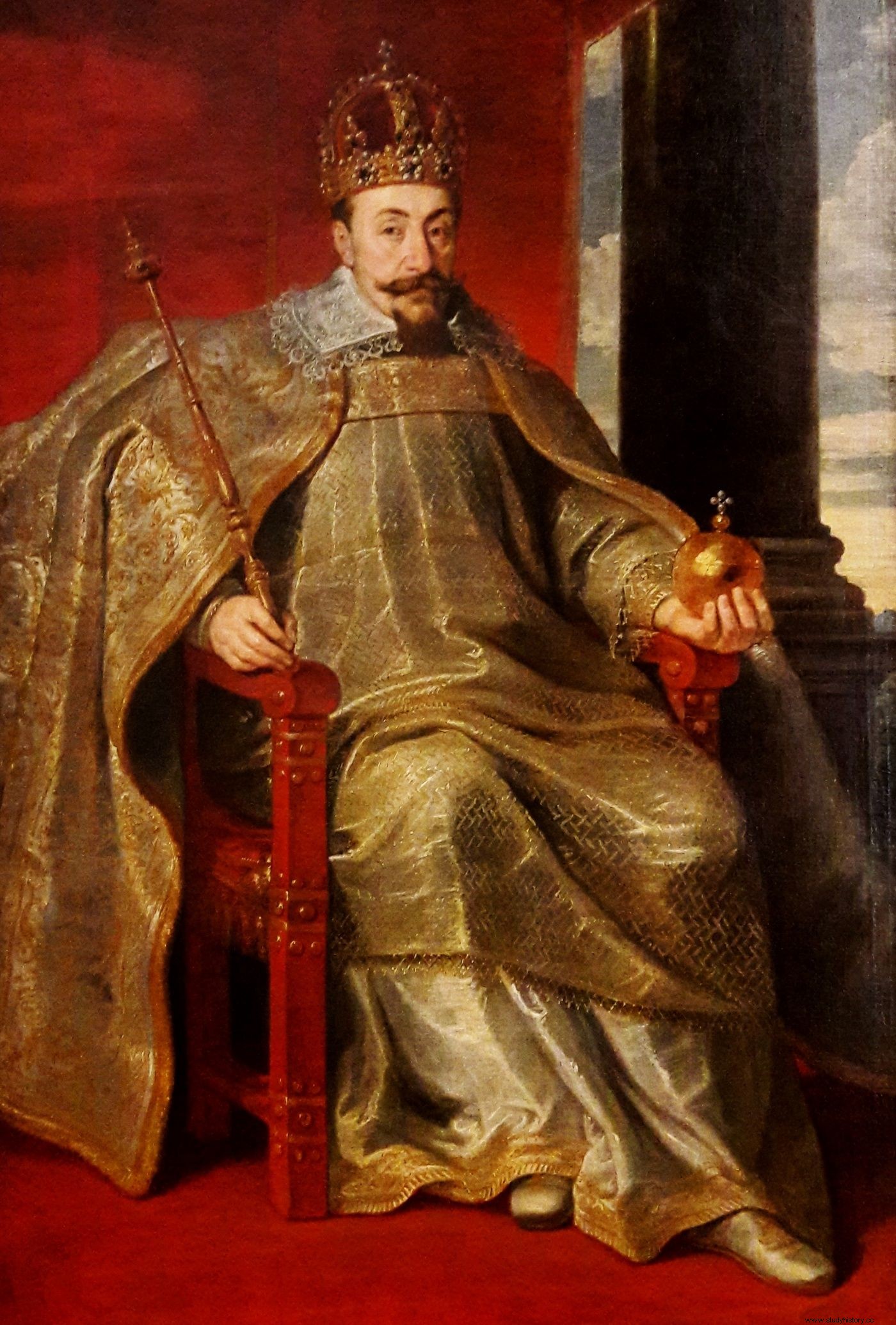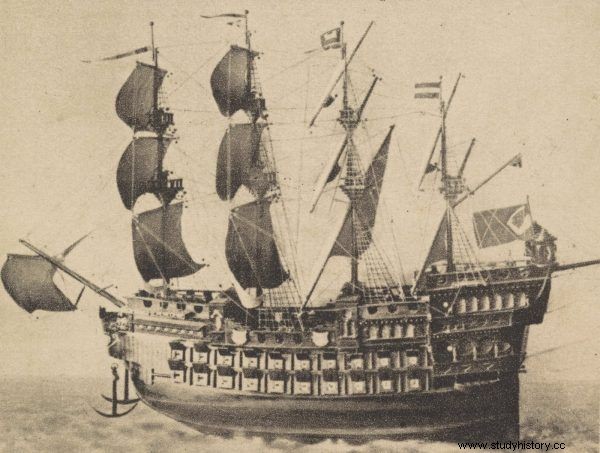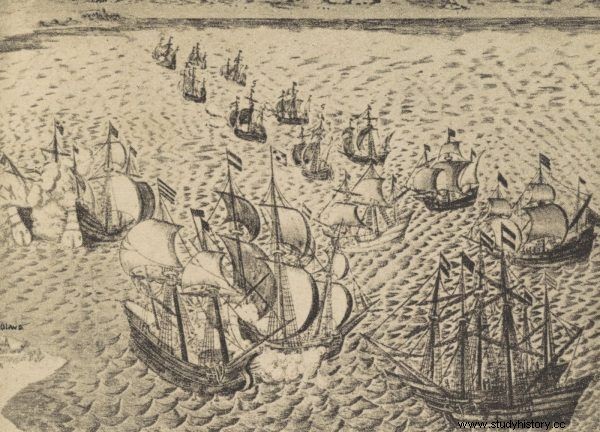King Zygmunt III Waza had an ambitious landing plan in Sweden. The ships intended for this, however, had to serve another purpose:repelling the Swedish invasion of Poland. And they did really gloriously!
Upon assuming power, Gustav Adolf inherited from his father the wars with Denmark and Moscow. However, in the first years of the reign of the new king, these conflicts were ended by treaties. In 1617, as a result of a favorable peace with the state of the tsars of Sweden, the entire coast of the Gulf of Finland fell.

"Battle of Oliwa", a fragment of a painting by Włodzimierz Jan Nałęcz.
The Scandinavian country was thus beginning to implement the great project of making the Baltic Sea "the inner Swedish lake". The next stage of this plan was to seize the territories belonging to or located in the orbit of the influence of the Polish Republic.
Spanish fantasies
As the Swedish king planned mainly offensive operations in the Baltic region, a large role was attached to the expansion of the fleet. A sufficient number of ships were needed to transport the troops and to cover the convoys. The ability to land landing craft was also important. A successful test for the Swedish naval forces was the attack on Livonia belonging to the Polish-Lithuanian Commonwealth in 1621. A fleet of 158 units with 14,000 soldiers on board was directed there. On September 25, 1621, the Swedes won a crucial victory, capturing Riga, the country's main port.
Power in the Polish-Lithuanian Commonwealth was then exercised by Sigismund III, also from the Vasa dynasty. For a short period he was king of both Poland and Sweden. He came into conflict with the Swedish elite and was deprived of the Swedish crown in 1599. Nevertheless, he still made plans to regain the throne in Stockholm. Their implementation also needed a fleet, while Sigismund III did not have one.

To think about a victory over his cousin, Sigismund III Vasa needed a fleet.
The Catholic monarch turned for help in this matter to ... Spain - a maritime power which, together with the Republic of Poland, was part of the Catholic political camp in Europe. The king planned to use foreign troops so that in the eyes of the Swedes it would not look like the invasion of their country by the Commonwealth. It was supposed to be simply a continuation of the struggle for power by two Swedish Vasa. In April 1623, the terms of the contract with the mercenary troops were already agreed, but in the end the whole operation did not take place.
The intimidated Gdańsk
The landing plans for Sweden were not without results. It was because of them that the construction of the Polish war flotilla began in Gdańsk. It was supposed to be part of a great invasion armada, but it turned out to play a completely different role. The first small two-masted ship, the "Yellow Lion", was launched in 1622. Soon it was time for the next units. The work was led by Scottish expert Jakub Murray.
The Swedish rulers of the Baltic Sea, of course, saw what was happening and decided to intervene. A fleet of 21 ships, with Gustaw Adolf on board one of them, influenced the roadstead of the Gdańsk port. King Zygmunt was in the city at the time. Swedish ships began to block Gdańsk, forcing the authorities of the city that enjoyed a lot of independence in the Crown to change its current policy. As a result, the inhabitants of Gdańsk forced King Sigismund to transfer the shipyard to Puck.
The landing projects in Sweden were ruined, but this small flotilla turned out to be very useful very quickly. Gustaw Adolf used Sigismund's Spanish conspiracies as a pretext for an "advance" invasion of Poland.
The military operations began at the turn of June and July 1626 with the landing of the 14,000-strong army of Gustaw Adolf in Piława, Prussia. The Swedes then struck Pomerania, blocking Gdańsk and interrupting sailing on the Vistula.
Salt water instead of beer
The Swedish fleet, at that time numbering 49 warships and about 150 transports, was responsible for delivering meals in Pomerania. The fleet also blocked the port of Gdańsk during the shipping period, i.e. from spring to the beginning of the winter storm season.
The Polish flotilla operating from Gdańsk, commanded by the Dutch admiral Arend Dickmann, attempted to attack small Swedish convoys. However, in the event of encountering a larger group of Swedish Zygmunt's ships, they retreated, seeking shelter in ports.
In the fall of 1627, the blockade of the Gdańsk port became a hard nut to crack for the Swedes. In mid-November, there was a shortage of food and beer, and diseases, including scurvy, were spreading among the crews. Sailors had to drink salt sea water. Admiral Nils Stiernsköld was due to withdraw the ships to Sweden in early December; his martyred men were looking forward to the time of departure. Meanwhile, Dickmann learned about the hopeless situation on enemy units and decided to take advantage of his weakening. On November 23, a decision was made in Gdańsk to attack the Swedish flotilla.

The port of Gdańsk based on Aegidius Dickmann etching from the beginning of the 17th century.
The first attempt, made three days later, proved unsuccessful. The next one, this time successful, was decided on November 28. In the morning, around six o'clock, six Swedish ships sailing from the Hel side were spotted in Gdańsk. The enemy flotilla, with around 700 sailors and soldiers on board, had a total of 140 guns.
To meet the opponent, Zygmunt Galleons, Fluites and Pins floated on the waters of the Gdańsk Bay. 10 ships were equipped with a total of 175 cannons. There were 390 sailors and 770 soldiers on their decks. When the Polish flotilla reached Oliwa, it was noticed by the Swedes.
Time of the Musketeers
The Swedish units sailed one after the other in a track formation. They made frequent turns, trying to adapt to the unfavorable winds. Two Polish Dickmann squadrons, five units each, were heading their way. Saint George, with the admiral aboard, was the first to make the waves, followed by the other four ships of the first squadron. The wind was favoring the Polish flotilla, so it was approaching the enemy at a fast pace.
Nils Stiernsköld was surprised by his opponent's attack. He ordered a return and his flagship "Tigern" positioned bow to the approaching "Saint George". Both galleons fired cannons; a Tigern bullet struck Dickmann's three-masted forward. The hit was not dangerous, however, and after a while "Saint George" was close to the enemy within a range of a handgun shot.
Soon the two ships caught their sides together. Polish mercenaries had an advantage in the ongoing firefight. The Swedes began to flee below deck, protecting themselves from bullets whistling everywhere. From the aft side of both ships the Polish "Water Maiden" suddenly appeared, directing fire on the "Tigerna".

Polish admiral ship, galleon "Saint George".
Stiernsköld, suddenly hit in the neck, staggered. Another bullet struck him in the back. Polish mercenaries, protected by blackened cuirasses and helmets, swarmed everywhere. They were breaking up on the deck of the enemy ship, confronting the Swedish soldiers who were still resisting. The mortally wounded Swedish admiral saw that there was no point in further fighting. He started shouting that he was surrendering the "Tiger". The Swedes proceeded to lay down their arms. The delighted Dickmann passed from the deck of the "Saint George" to the captured enemy ship.
Meanwhile, the Swedish "Pelikanen" was approaching both galleons. Saint George fired a volley in its direction, causing considerable damage on board. The Swedes displayed a white flag as a sign of surrender. Suddenly, however, a favorable wind blew and, taking advantage of the situation, the "Pelikanen" fled towards the exit from the bay.
The "Salting" massacre
Then a cannonball struck the Tigern's deck, right next to the ordering Dickmann. The admiral lost both legs and gave up the ghost. It is not entirely certain who fired the shot. They could have been the gunners from the Polish "Flying Deer", whose crew did not notice that the "Tigern" had been captured.

The Battle of Oliwa on a Dutch engraving.
Meanwhile, closer to the coast, the fight of another Swedish galleon - "Solena" - with the second Polish squadron began. After a short fire exchange, the small galleon "Aquarius" engaged the enemy and began boarding. Two more ships also approached the Swedish unit, trying to surround it. Polish mercenaries began to storm the enemy deck, clashing with the Swedes.
They fired pistols, fought with rapiers, axes and dards, i.e. short pikes. One of the sailors of "Wodnik" suddenly jumped onto the central mast of the "Solena", climbed to its top and took off the flag. Seeing the advantage of the attackers, the Swedish skipper decided that the fight was lost and decided to take a suicide step.

The Battle of Oliwa in Gdańsk.
He ran down to the powder magazine and threw the flaming torch at the gunpowder barrels. The air was shaken by a powerful explosion, massacring the Swedish and Polish soldiers engaged in combat. The splinters also fell on the "Wodnik" attached to "Solen", seriously damaging it.
The crews of the remaining four ships of Gustaw Adolf, noticing the loss of "Tigern" and "Solen", started to flee towards Piława. Six lighter Polish units followed, but failed to get close enough to fire. The range of the cannons at that time was not impressive, it was at most 1.5 kilometers. Unable to catch up with the enemy, the Polish ships returned to Gdańsk.
Sunset at noon
The Battle of Oliwa ended with a decisive Polish victory. One Swedish galleon was destroyed, one damaged and one captured, killing 160 enemy sailors and soldiers, and capturing 100. The Poles had two galleons badly damaged and 60 killed. Both commanders of the fighting flotillas - Dickmann and Stiernsköld - fell in the fight.
The Zygmunt propaganda presented the fight at Oliwa in the West as a significant Polish victory. Considering the weakness of the Polish fleet, it was indeed a great success. It is also true, however, that he had virtually no influence on the further course of the war. The Swedish fleet was too strong for the loss of two galleons to seriously harm it. However, the whole war turned out to be victorious for the Republic of Poland.
***
You can read about the spectacular victories of our weapon in our latest book "Polish triumphs" . Learn about the clashes that changed the course of history with this richly illustrated publication. From victorious fights in the times of Bolesław the Brave, to fierce battles in World War II. Successes that every Pole should remember.
Find out more:
- Discant J.W., Oliwa 1627 , Bellona, Warsaw 1993.
- Koczorowski E., Oliwa 1627 , Morskie Publishing House, Gdańsk 1976.
- Krwawicz M., Fighting to defend the Polish coast in 1627 and the battle of Oliwa , MON Publishing House, Warsaw 1955.
- Podhorodecki L., Rapier and Koncerz. From the history of the Polish-Swedish wars , Book and Knowledge, Warsaw 1985.
- Sikora R., Polish military in the era of the Polish-Swedish war 1626-1629. A crisis of a superpower ., Sorus Publishing House, Poznań 2005.
- Wisner H., Zygmunt III Waza , Ossolineum, Wrocław 2006.
